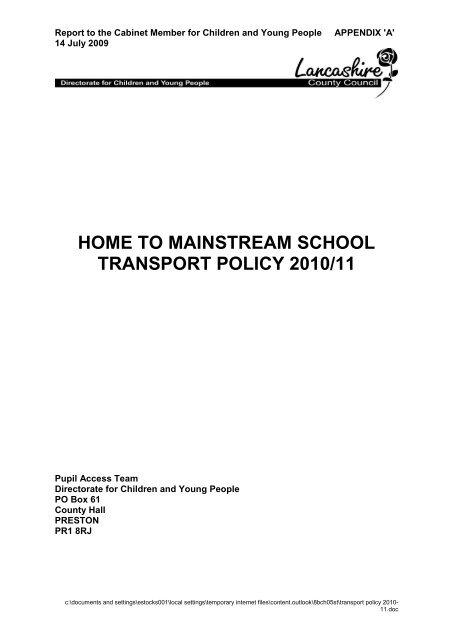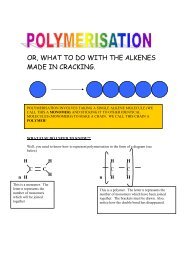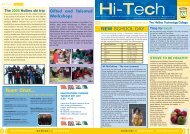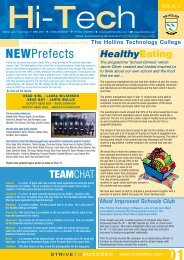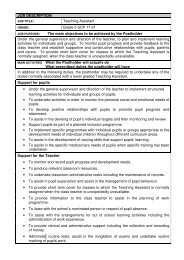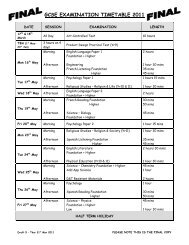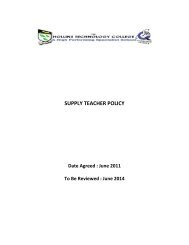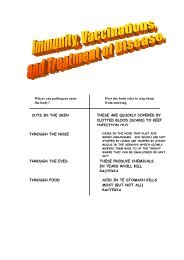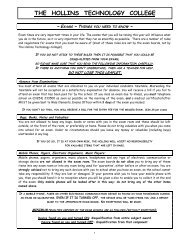Home to School Transport Policy 2010/11
Home to School Transport Policy 2010/11
Home to School Transport Policy 2010/11
You also want an ePaper? Increase the reach of your titles
YUMPU automatically turns print PDFs into web optimized ePapers that Google loves.
Report <strong>to</strong> the Cabinet Member for Children and Young People14 July 2009APPENDIX 'A'HOME TO MAINSTREAM SCHOOLTRANSPORT POLICY <strong>2010</strong>/<strong>11</strong>Pupil Access TeamDirec<strong>to</strong>rate for Children and Young PeoplePO Box 61County HallPRESTONPR1 8RJc:\documents and settings\es<strong>to</strong>cks001\local settings\temporary internet files\content.outlook\8bch05st\transport policy <strong>2010</strong>-<strong>11</strong>.doc
- 2 -SECTION A – PUPILS AGED 5-161. LEGAL BACKGROUNDThe provision of free transport for pupils aged 5-16 is based on Section 509 (1)of the Education Act 1996 as amended by the Education and Inspections Act2006. The County Council provides transport assistance <strong>to</strong> pupils who livebeyond the statu<strong>to</strong>ry walking distance between home and the nearest suitableschool.The statu<strong>to</strong>ry walking distances are defined as two miles (3.218688 km) ormore for a child up <strong>to</strong> 8 years of age, and three miles (4.828032 km) or morefor a child aged 8 years or over, the distances <strong>to</strong> be measured by the shortestsuitable route, as determined by the County Council.A parent's right (derived from Section 4<strong>11</strong> of the Education Act 1996) <strong>to</strong>express a preference for a place at a particular school does not au<strong>to</strong>maticallyinclude a right <strong>to</strong> assisted transport <strong>to</strong> the school. Responsibility for attendanceat school rests with the parent/carer.Pupils whose parents have low incomes and who are in Years 7-<strong>11</strong> insecondary schools are entitled <strong>to</strong> travel assistance if they attend one of theirthree nearest schools providing the distance exceeds two miles but is less thansix miles.For pupils attending primary schools whose parents have low incomes statu<strong>to</strong>rywalking distance continues <strong>to</strong> be two miles for pupils aged eight years of age orover.The County Council has a separate policy on the provision of transport for pupils withstatements of special educational need.2. COUNTY COUNCIL POLICY ON ENTITLEMENT(a)(b)(c)To be eligible for consideration for transport assistance under this policy,the pupil’s normal place of residence must be within the administrativearea of Lancashire County Council.If a child attends the nearest suitable school, as determined by the CountyCouncil, at which a place is available, assistance with the cost of travelwill be provided if the designated shortest walking route <strong>to</strong> the school isthree miles or more in the case of pupils eight years of age and over, ortwo miles or more in the case of pupils under eight years of age.In the case of families with low incomes free travel will be provided<strong>to</strong> one of the three nearest suitable schools for secondary agedpupils provided the school is between two and six miles from theirhome. Additionally for parents with low incomes whose child(ren)attend a school on the grounds of parental religion or belief,
3 -transport will be provided <strong>to</strong> the nearest suitable denominationalschool up <strong>to</strong> a distance of 15 miles.The distance in excess of three miles will be calculated by reference<strong>to</strong> road routes not walking routes. Parents will be asked <strong>to</strong> providesubstantial evidence of their religion or belief <strong>to</strong> demonstrate theirclaim. See Appendix C for definitions of religion or belief.(d)(e)For pupils attending primary schools who reach the age of eight yearsand whose families are on low income ,they will continue <strong>to</strong> receive travelassistance if they live two miles or more from their nearest suitableschool. The distance will be measured by the shortest walking route.To qualify for assistance on low income grounds pupils must be eligiblefor free school meals or the parents are receiving the maximum amoun<strong>to</strong>f Working Tax Credit.Pupils who qualify for assistance on low income grounds will be reassessedannually <strong>to</strong> confirm that they still meet the qualifying criteria.Pupils whose parents cease <strong>to</strong> be entitled on low income grounds duringthe school year will retain their concession until the end of the academicyear. A re-assessment of their case will then be undertaken.(f)(g)(h)(i)Where a parent obtains a place for a child at a school maintained byanother Local Authority, assistance with travel will only be provided wherethis is the nearest suitable school, as determined by the County Council,at which a place is available. In cases near the Lancashire border wherethe nearest suitable school is considered <strong>to</strong> be a Lancashire school, butthere is a nearer 'out of county school,' expenses will additionally be paid<strong>to</strong> the 'out of county' school', provided that the distance criterion is met.In areas served by denominational schools, denominational reasons forchoosing a school are taken in<strong>to</strong> account when assessing eligibility forassistance with the cost of travel. To qualify for assistance under thiscriterion a pupil must have been admitted <strong>to</strong> the school on denominationalgrounds as outlined in Clause 5 (a) (ii) below (see paragraph 2k).If a secondary aged pupil is allocated a place at a school which is not oneof a parent's three expressed preferences then travelling expenses will bepaid if the distance criterion is met, assuming there is no nearer schoolavailable within statu<strong>to</strong>ry walking distance.Pupils who are in receipt of travelling expenses and who reside two milesor more but less than three miles from the primary school attended willcontinue <strong>to</strong> receive assistance until the end of the academic year in whichthe pupil becomes eight years of age. However if the parents meet thelow income criteria outlined in clause 2 (e) above, the primary aged pupilwill continue <strong>to</strong> receive travelling expenses until they leave the school
4 -3. OTHER FACTORS RELATING TO NON-ELIGIBILITYThe following fac<strong>to</strong>rs are not considered in determining eligibility for assistance<strong>to</strong>wards the cost of school transport.(a)Brothers and SistersAlthough the right of a parent <strong>to</strong> express a preference for a particularschool is recognised and the presence of an elder brother or sister inattendance at the school of the parent's choice is an important fac<strong>to</strong>r indetermining school admissions, travelling expenses will not be paid onthis basis, except under the special circumstances outlined in Section 6.(b)Family AssociationsPast and present family associations with a school cannot beconsidered as grounds for the payment of travelling expenses.(c)Financial CircumstancesThe financial circumstances of the family are only considered as a fac<strong>to</strong>rin determining eligibility for assistance <strong>to</strong>wards the cost of travel <strong>to</strong>school, where the pupils are from families with a low income. Parentsnormally have the option of choosing a school within the statu<strong>to</strong>rywalking distance of their home. If this option is not available, the cost oftravel <strong>to</strong> school will be met.(d)Single Sex or Mixed <strong>School</strong>Preference for a single sex or conversely for a co-educational schoolcannot be regarded on its own as a valid claim for travelling expenses.Pupils in secondary schools (Years 7-<strong>11</strong>) whose parents meet the lowincome criteria can be considered for assistance under these criteria ifthey can substantially demonstrate that the school attended is thenearest school which meets the parental religion or belief and thedistance is between two and fifteen miles. (See appendix C).(e)Selection TestsThe passing of an entrance examination for a school is not regarded initself as justification for the payment of travelling expenses.4. THE BASIS OF PAYMENT(a)Issue of Travel Passes
5 -Pupils who are eligible for free transport will be issued with a travel passfor a commercial or non-commercial bus service, a contracted vehicle ora railway service, at the discretion of the County Council. The CountyCouncil when arranging transport will endeavour <strong>to</strong> provide maximumjourney times of 45 minutes for primary aged children and 75 minutes forsecondary aged pupils. <strong>Transport</strong> will be provided from a pointreasonably near <strong>to</strong> the parent’s home and the pupil’s school. The CountyCouncil reserves the right <strong>to</strong> withdraw transport for pupils who seriouslyor persistently misbehave on school services.(i)(ii)(iii)(iv)(v)Once a travel pass has been issued the County Council will makea charge for a replacement if it is lost/defaced during its issueperiod. The current charge is £15 (£10 for pupils whose parentsmeet the low income criteria as stipulated in (ii) below.)Fares paid whilst awaiting a replacement pass will not berefunded except for those pupils in receipt of free school meals orwhose parents are in receipt of the maximum amount of workingtax credit.Parents should note that it normally takes up <strong>to</strong> ten workingdays (and longer in busy periods such as August/September)for a pass <strong>to</strong> be issued from the date the application isreceived by the Council. Parents are advised <strong>to</strong> apply inplenty of time before the pass is required <strong>to</strong> avoid having <strong>to</strong>pay fares which may not be refunded. Fares paid whilstawaiting the arrival of a travel pass will only be refunded wherethe delay is caused by the County Council.Fares will not normally be refunded in cases where eligiblepupils are unable <strong>to</strong> show their pass <strong>to</strong> the driver and a fareis incurred.It is the responsibility of the parents or carer <strong>to</strong> ensure that buspasses are renewed each school year. The process is notau<strong>to</strong>matic. Forms will be sent out <strong>to</strong> children who have hadpasses in April and new Year 7 pupils who the County Councilconsiders will be eligible, will be sent application forms in Mayeach year. If parents do not receive a renewal from they mustcontact their local area education office by the end of May, <strong>to</strong>ensure that a pass will be issued in good time for thecommencement of the school year.(b)Reimbursement of Travel Costs(i)BicycleAn allowance at a rate determined by the Direc<strong>to</strong>rate for Childrenand Young People will be paid when a pupil who is eligible under
6 -the County Council's policy <strong>to</strong> receive travelling expenses uses abicycle <strong>to</strong> travel the whole or part way <strong>to</strong> school.(ii)Mo<strong>to</strong>r Cycle/Car AllowancesIn the absence of suitable public transport or private hirearrangements and at the discretion of the County Council, parentsmay be reimbursed for whole or part journeys at a ratedetermined by the Direc<strong>to</strong>rate for Children and Young People.Parents should be aware of the possible insurance implications ofconveying pupils for gain.(c)Pupils not Entitled <strong>to</strong> Free Travel To <strong>School</strong>Pupils not entitled <strong>to</strong> free transport should be able <strong>to</strong> travel on schoolbuses contracted by the County Council subject <strong>to</strong> places beingavailable on payment of the daily fare.Season Tickets can be purchased termly or annually and attract adiscount of 20% off the cost of the daily fares. These are available bycontacting the <strong>School</strong> Traveline on 01772-534588.In the very small number of cases where it is not possible <strong>to</strong> pay a dailyfare on the school taxi, which has been hired because of an absence ofsuitable public transport, any spare seats on the vehicle may beallocated <strong>to</strong> suitable pupils/students subject <strong>to</strong> spaces being availableand not required for future statu<strong>to</strong>ry travellers. Calculation of costs willbe provided upon request.5. DEFINITION OF TERMS(a)Appropriate or Suitable <strong>School</strong>The nearest suitable school is determined by the County Council and isusually the geographically nearest school able <strong>to</strong> provide educationsuitable <strong>to</strong> the age of the pupil, at which a place is available.In determining the nearest school consideration will be given <strong>to</strong> theshortest suitable walking route between home and school. To obtain themeasurement the County Council will measure from the nearestboundary entrance of the property (eg gate) <strong>to</strong> the nearest entrance <strong>to</strong>the school which can be accessed on foot and is available for pupils.Private driveways <strong>to</strong> homes and within schools are not included in themeasurement. It is the parent/carers' responsibility, where appropriate,<strong>to</strong> accompany their child on the journey <strong>to</strong> and from school.In determining whether places are available at a nearer school, accountwill be taken of the position at the time prior <strong>to</strong> places being allocated,except where there has been a significant change in domestic
7 -circumstances since that time, in which case the availability of placeswhen the application for assistance with home <strong>to</strong> school transport ismade, will be considered. In the case of children moving in<strong>to</strong> an area orchanging schools, the availability of places will be determined at thetime an application for a school place is made.For community and controlled secondary schools which usegeographical priority areas as part of the admissions criteria, thegeographical priority area school is considered <strong>to</strong> be the nearest suitableand travelling expenses will only be paid <strong>to</strong> the priority area school,provided the distance criterion is met. In circumstances, however, wherethere is a school or schools closer <strong>to</strong> the home address than thegeographical priority area school, the Council will meet the cost oftravel <strong>to</strong> the nearest of those schools in addition <strong>to</strong> thegeographical priority area school, provided that the distancecriteria is metIf at the time of allocation, a place is offered in accordance with parentalpreference at a school over the statu<strong>to</strong>ry walking distance but a place isavailable at a nearer suitable school within the statu<strong>to</strong>ry walkingdistance, assistance with travel <strong>to</strong> the allocated school will not be given.For those applications however where the child is not attending thenearest suitable school, but where no place is available at anotherschool within statu<strong>to</strong>ry distance, the application will be subject <strong>to</strong> acentral review process, where the circumstances of the family, thepreferences expressed and the availability of alternative schools wouldbe taken in<strong>to</strong> consideration.(i)Determining three nearest schools.When establishing the three nearest schools for secondary agedpupils who qualify for transport assistance on low incomegrounds, the County Council-(a) will not consider denominational schools for those pupils whodo not desire a denominational education.(b) will not consider single sex schools for pupils who do not fulfilthe gender for that particular school(c) will not consider grammar schools for those pupils notselected for those schools.(d) In cases where pupils are applying for school placesoutside the normal admissions round, the three nearestschools will be those with places available at the time thenew school place is allocated.
8 -(e) In cases of pupils applying within the normal admissionsround, the three nearest schools will be those that couldhave offered a place at the time places are allocated hadthey received an application from the pupil.(ii)Denominational <strong>School</strong>sThe County Council's transport policy reflects parental preferenceof school on grounds of a particular denominational affiliation, asshown below. In all cases transport will be restricted <strong>to</strong>denominational schools which are up <strong>to</strong> 15 miles from the child’shome. (This mileage restriction <strong>to</strong> apply from September 2009onwards <strong>to</strong> new pupils only admitted <strong>to</strong> Year 7 in secondaryschool).(a)(b)(c)(d)(e)(f)In the case of Roman Catholic pupils, the Roman Catholicschool serving the parish in which the pupil lives will beconsidered <strong>to</strong> be the nearest suitable school.In the case of pupils wishing <strong>to</strong> attend a Church of Englandaided school, denominational considerations are taken in<strong>to</strong>account if the school applied for serves the area of thepupil's home address.In establishing "denominational reasons" for the preferenceof school, evidence will be sought from the Headteacher orArea Education Office that a place was granted ondenominational grounds, ie that the pupil was (or would havebeen had the school not been undersubscribed) admittedunder the denominational criteria contained within theschool's agreed admissions policy.Pupils attending a denominational school which does notidentify a particular parish in its admission criteria will onlyreceive travel assistance if it is the geographically nearestdenominational school and it is over the statu<strong>to</strong>ry distance,subject <strong>to</strong> the exceptions stipulated at Section 6 (b).In cases where a pupil chooses <strong>to</strong> attend a nearerdenominational school of the same affiliation than thenearest parish school and has been admitted <strong>to</strong> that schoolon denominational grounds then travelling expenses willadditionally be paid provided the distance criterion is met.For pupils from low income families travelling expenses willbe met for any pupil who attends their nearest suitableschool of the parents faith or belief provided the distance isbetween 2 and 15 miles.
9 -(iii)<strong>School</strong>s Maintained by other Local AuthoritiesThe County Council's policy is <strong>to</strong> assist with travelling expenses inrespect of Lancashire pupils admitted <strong>to</strong> schools maintained byother local authorities in those cases where it is the nearestsuitable school at which a place is available."Equivalent costs" of transport <strong>to</strong> the nearest suitable school willcontinue <strong>to</strong> be paid for pupils allocated <strong>to</strong> school prior <strong>to</strong>September 2005, who were admitted <strong>to</strong> schools maintained byother local authorities, provided the nearest suitable school isthree miles or more from the home address. Please see Note 2(f)(b)Compulsory <strong>School</strong> AgeLegal entitlement <strong>to</strong> free home <strong>to</strong> school transport relates <strong>to</strong> pupils ofstatu<strong>to</strong>ry school age, ie 5 <strong>to</strong> 16. The County Council has extended itsprovision of free home <strong>to</strong> school transport as outlined below:-(i)Admission <strong>to</strong> Primary <strong>School</strong>sPupils under statu<strong>to</strong>ry school age attending primary schools aspart of the County Council's primary admission arrangements willbe eligible for travel expenses on the same basis as pupils ofstatu<strong>to</strong>ry school age.(ii)Pre-<strong>School</strong> ProvisionTravelling expenses are not payable in respect of attendance atnursery schools and classes.(c)Independent <strong>School</strong>sThe County Council's policy is not <strong>to</strong> offer assistance with home <strong>to</strong> schooltravel expenses <strong>to</strong> pupils who attend independent schools.(d)Shortest Route/Unsuitable RoutesWhen assessing claims for travel assistance the County Council willmeasure the distance from home <strong>to</strong> school using the shortest walkingroute. This may include metalled roads, recognised footpaths andbridleways. Distances are usually measured using an electronicgeographical information system (GIS). However on occasions the routemay be measured on foot using a pedometer. If in the opinion of theCounty Council the shortest walking route could be interpreted asunsuitable for children <strong>to</strong> walk accompanied by an adult, an alternativelonger walking route might be considered. Attached at Appendix A arethe County Council's guidelines <strong>to</strong> which it has regard whenassessing the suitability of walking routes. Where all the routes <strong>to</strong> a
10 -school are deemed <strong>to</strong> be unsuitable, the shortest walking route will beused <strong>to</strong> establish entitlement.(e)Definition of '<strong>Home</strong>'In circumstances where pupils reside at two different addresses duringthe school week due <strong>to</strong> co-parenting arrangements, the County Councilwill usually only meet the costs of transport from one of those addresses,subject <strong>to</strong> the usual eligibility criteria being satisfied.The address from which eligibility will be assessed will be that which inthe County Council’s opinion is the pupil’s main or habitual residence.In considering the issue of main or habitual residence the CountyCouncil will consider such matters as the address which was used <strong>to</strong>obtain the school place, the address at which the pupil spends mostschool days during term time weeks and the address used forregistration at doc<strong>to</strong>rs and dentists etcIn the event that a child spends an equal portion of the school week ateach address, the County Council will usually consider the main address<strong>to</strong> be that from which the child wakes on the most school days duringterm time weeks, school days being Monday <strong>to</strong> Friday.6. SPECIAL CASES(a)GeneralThe County Council will consider all circumstances which are relevantfor the purpose of facilitating the attendance of a child at school andassistance with transport may be given at the discretion of the ExecutiveDirec<strong>to</strong>r for Children and Young People in special cases.(i)In particular, if parents change address and the new address isthree miles (two miles in the case of low income families) or morefrom the school, travelling expenses will be paid in respect ofpupils in their last year at primary school (Year 6) and pupils insecondary schools who have commenced external examinationcourses (normally Years 10 and <strong>11</strong>). This provision does notextend <strong>to</strong> siblings who are outside the specified age groups,except as stated in (ii) below. The County Council will take anumber of fac<strong>to</strong>rs in<strong>to</strong> account when reaching a decision. Thesefac<strong>to</strong>rs will include the cost of the transport, the ease oftransferring <strong>to</strong> another school and the distance involved. Alsowhether the pupil has been attending the nearest suitable school<strong>to</strong> the previous address and whether the move has been voluntaryor involuntary.
<strong>11</strong> -The Council will also require evidence confirming the date ofremoval when considering the above cases.(ii)In instances where parents moving new <strong>to</strong> the area outside thenormal admissions round find that the nearest primary schoolcannot accommodate their child, they may have <strong>to</strong> enrol their childat the next nearest school where a place is available. If in lateryears younger siblings subsequently wish <strong>to</strong> attend this schoolwhen places may be available for them at a nearer school, thentravelling expenses will be paid for all the children provided thatthe distance criterion as outlined in 2(b) and (d) is met. Forassistance <strong>to</strong> be granted <strong>to</strong> future siblings, an older sibling mustbe receiving transport assistance and be in attendance at theschool when the younger child commences at the school(iii) In cases where travelling expenses are granted for a pupilwho removes during Y6, the Council will additionally meetthe cost of travel for any younger siblings <strong>to</strong> attend the sameschool until the end of that academic year. Travellingexpenses will only continue <strong>to</strong> be paid if at the date that theelder sibling leaves the school, that the school attended isthe nearest school which can offer places.(iv) Where parents choose a more distant school for their child, it isassumed that they have accepted responsibility for the payment oftravelling expenses and assistance with transport will not beprovided. If however there is subsequently a significant change indomestic circumstances which might prevent the child fromattending that school, travelling expenses may be paid <strong>to</strong> enablethe child <strong>to</strong> continue attending the more distant school, providedthe distance criterion is met. Such cases will only be considered ifit is not possible <strong>to</strong> offer the child a place at a nearer school whichis less than statu<strong>to</strong>ry walking distance, and the parent is able <strong>to</strong>provide compelling evidence <strong>to</strong> the Authority that the significantchange of circumstances is preventing the child from attending themore distant school.Attached at Appendix B are details of those child specificcircumstances in which the County Council will consider theprovision of discretionary transport.(b)<strong>School</strong> SpecificThe County Council has exercised its discretion in a small number ofexceptional circumstances and granted the following 'school specific'exceptions <strong>to</strong> the normal transport policy:.
12 -(i)Pupils living in Wal<strong>to</strong>n le DaleFor pupils admitted on denominational grounds Chorley StMichael's CE High <strong>School</strong> is the nearest appropriate Lancashireschool The County Council will meet the cost of travel <strong>to</strong> thisschool and will additionally meet the cost of travelling expenses <strong>to</strong>Hut<strong>to</strong>n Grammar <strong>School</strong> for pupils admitted on denominationalgrounds.(ii)Pupils living in Burnley and PendleFor pupils admitted on denominational grounds Accring<strong>to</strong>n StChris<strong>to</strong>pher's CE is the nearest Church of England <strong>School</strong> forthese pupils. In addition, travelling expenses will be paid forpupils living in Burnley and Pendle who are admitted ondenominational grounds <strong>to</strong> Blackburn St Wilfrid's CE High <strong>School</strong>.(iii)Pupils attending Preesall St Aidan's CEHS and Cros<strong>to</strong>n BishopRaws<strong>to</strong>rne CEHS.Preesall St. Aidan's and Cros<strong>to</strong>n The Bishop Raws<strong>to</strong>rne Churchof England Aided <strong>School</strong>s are considered as the nearest suitableschools for home <strong>to</strong> school transport purposes, for nondenominationalpupils living in the appropriate foundationecclesiastical parishes. (See each school's admission policies fordetails). If the parents of these pupils can demonstrate that theyhave strong philosophical convictions as <strong>to</strong> why admission <strong>to</strong>these schools would not be deemed appropriate (such asmembership of a secular society) the nearest community highschool will be considered <strong>to</strong> be the nearest suitable school.(iv)Pupils living in the Ribble ValleyPrior <strong>to</strong> September 2008, when assessing applications forassistance with home <strong>to</strong> school transport for non-Catholic childrenliving in the Ribble Valley area, the following policy applied.Provided a non-Catholic pupil living in the geographical priorityareas for either Bowland or Ribblesdale High <strong>School</strong>s lived threemiles or over from either school, entitlement <strong>to</strong> transport <strong>to</strong> thatschool was granted. <strong>Transport</strong> continued <strong>to</strong> be provided for pupilswho lived in the catchment area for Clitheroe Royal Grammar<strong>School</strong> whose address was three miles or more from the school.This exception has however now been withdrawn for pupilsstarting at the above schools from September 2008 onwards.(v)Pupils living in Tarle<strong>to</strong>n and Hesketh BankFor pupils living in Tarle<strong>to</strong>n and Hesketh Bank their nearest CEHigh <strong>School</strong> is Cros<strong>to</strong>n The Bishop Raws<strong>to</strong>rne. Travelling
13 -expenses are also paid for these pupils <strong>to</strong> attend Hut<strong>to</strong>n Grammar<strong>School</strong> if admitted on denominational grounds.7. PROVISION OF TRANSPORT TO MEDICAL OR OTHER PROFESSIONALAPPOINTMENTSThe County Council does not help those parents whose children are entitled <strong>to</strong>home <strong>to</strong> school transport assistance with any additional journeys during theschool day in connection with medical or other professional appointments.8. COUNTY COUNCIL POLICY IN CIRCUMSTANCES WHERE TRAVELLINGEXPENSES ARE AWARDED IN ERRORWhere a pupil is attending their nearest school and it is found that travellingexpenses have been awarded in error, the County Council will rectify thematter. Parents will be advised of the error and be given notice of thewithdrawal of assistance. The notice will be for the balance (if any) of the termin which the error is discovered plus one complete term.9. APPEALSParents can appeal against a decision not <strong>to</strong> provide transport or against thedetailed arrangements made, if the parents believe that they have exceptionalmitigating circumstances. The Student Support Appeals Panel will considerany written representations made by parents in support of their appeal but doesnot permit oral representations. Its decision is final and binding unless there issome significant change in circumstances which would merit the case beingreconsidered.Appeal forms are available from Local Area Education Offices.Should an appeal be upheld the Council will only consider retrospectivere-imbursement of travelling expenses back <strong>to</strong> the date the appeal formwas received by the County Council.
Appendix A<strong>Home</strong> <strong>to</strong> <strong>School</strong> <strong>Transport</strong> <strong>Policy</strong>- 14 -UNSUITABLE ROUTES POLICYIn cases where the shortest walking route between home and school is within thestatu<strong>to</strong>ry mileage distance and a parent believes that the walking route <strong>to</strong> the schoolcould be considered as unsuitable, the County Council will upon a request from theparent, undertake an assessment of the whole route, or those parts of the routewhich the parent deems <strong>to</strong> be unsuitable. Routes will not be considered for theirsuitability if they do not meet the criteria listed below. When considering walkingroutes the County Council will take in<strong>to</strong> account footways, verges, walkable roadsidestrips, footpaths and bridleways. However, the absence of these does not alwaysconstitute the route as being unsuitable (See section 5)The statu<strong>to</strong>ry mileage criteria are:2 miles or over for pupils under eight years of age.2 miles or over for pupils over eight years of age if entitled <strong>to</strong> free schoolmeals or parents receiving maximum amount of Working Tax Credit, until theend of their Y6 at primary school.3 miles or over for pupils over eight years of age.The County Council’s assessment of the route will consider the following fac<strong>to</strong>rs:1. Alternative RoutesIf the shortest walking route is felt <strong>to</strong> be unsuitable, however an alternativeroute or routes are available which may be classed as ‘suitable’ and which fallwithin the distance criteria, then assistance with travel costs will not begranted.2. Accompanied by a suitable adult.Parents have the primary responsibility for ensuring their child’s safe arrival atschool. In all cases when assessing the suitability of routes the CountyCouncil will assume that the child is accompanied, where necessary, by aparent or other responsible person and is suitably clad.Therefore the existence of the following fac<strong>to</strong>rs will not usually make a routeunsuitable, although they would be taken in<strong>to</strong> account:a) lonely routesb) moral dangersc) canals, rivers, ditches, dykes, lakes and pondsd) railway crossingse) routes without street lighting.The responsibility for the child <strong>to</strong> be accompanied as necessary rests with theparent.
15 -3. Availability of a footway, verge, walkable roadside strip, footpath orbridlewaya) If these are available then these parts of the route cannot beconsidered <strong>to</strong> be unsuitable subject <strong>to</strong> (b) below.b) If the width of the roadside footway/verge/roadside strip falls <strong>to</strong> lessthan 1m in width and an alternative footway is not available then trafficcounts will be necessary at the points where this happens inaccordance with the width of the road as shown in the table in Clause 5below.c) Where it is necessary <strong>to</strong> make road crossings <strong>to</strong> access an alternativefootpath or a footway in excess of 1m width, the volume of traffic on theroad at those points will be considered taking in<strong>to</strong> account the ‘crossingparameters’ outlined in Clause 4 below.4. Suitable Crossing PointsWhen undertaking the measuring of walking distances <strong>to</strong> school the CountyCouncil will take in<strong>to</strong> account suitable road crossing points when assessingthe suitability of the route.Where road crossings are necessary it will be assumed that if the half hourtwo way traffic flow (one way on dual carriageways) is below 240 vehicles perhour, the road should be reasonably able <strong>to</strong> be crossed.Conversely, where the half hour two way traffic flow (one way on dualcarriageways) is in excess of 700 the road is assessed as being unsuitable <strong>to</strong>cross, unless there are ‘traffic interrupters’ (eg traffic lights) which providesuitable crossing gaps at reasonable intervals.The assessments will not apply if pedestrian crossing facilities are provided.In cases where central pedestrian islands are provided in the centre ofthe road <strong>to</strong> assist pedestrian crossing movements and there are noother pedestrian facilities available (ie pelican/zebra crossing), trafficflows will only be taken in one direction.For roads where the half hourly traffic flow is between 240 and 700 vehicles,the ability of being able <strong>to</strong> cross the road comfortably four or more times ineach five minute period would normally indicate a road which is reasonablyable <strong>to</strong> be crossed by an accompanied child. In cases where centralpedestrian islands are available the number of crossings will be takenfrom the island <strong>to</strong> the footway and vice versa.The County Council will undertake a half hourly traffic count for both themorning and afternoon during school terms <strong>to</strong> coincide with the times theroute would be walked.
16 -When determining the number of vehicles in any time period thefollowing 'passenger car equivalent values' (PCU's) will be used asmultiplication fac<strong>to</strong>rs:3 pedal cycles 1PCU2 mo<strong>to</strong>r cycles 1PCU1 car 1PCU1 LGV (under 3.5<strong>to</strong>nnes) 1PCU1 Bus/Coach 2PCU1 HGV 2PCU5. Roads without FootwaysOn roads less than 6.5m in width, where there is no public footpath orwalkable verge or refuge points and where the traffic exceeds the maximumvehicle numbers per hour relevant <strong>to</strong> the width of road shown in the tablebelow, these would be deemed unsuitable routes.In addition if the proportion of Heavy Goods Vehicles (HGV’s) using the route ismore than 10% of the highest <strong>to</strong>tal traffic volume figure, relative <strong>to</strong> the road widthshown in the table below, the route would be deemed unsuitable.In undertaking the assessment however, if there are verges which may be‘stepped on<strong>to</strong>’ <strong>to</strong> avoid vehicles, where there is insufficient road width for thevehicle/s <strong>to</strong> pass, then these parts of the route are not deemed <strong>to</strong> be unsuitable,unless the number of vehicles exceeds that which corresponds <strong>to</strong> theappropriate road width shown in the table below.A step off or verge is a minimum area that a pedestrian could use as a refugewhich is defined as 1.5m in length and 0.5m in depth and relatively level.Where no ‘step-off’ exists for any part of the route the number of vehicles usingthe route will be counted at this point in accordance with the road widths shown inthe table below.Acceptable maximum length of Acceptable number of vehicles per hour by road widthSingle sections of road withoutVerges or refuge beforeBroken by a verge or refuge >3.5m road 3.5>4.5m road 4.5>5.5m road 5.5>6.5m roadwidth width width width10m 201-240 301-360 401-480 501-60015m 161-200 241-300 321-400 401-50025m 121-160 181-240 241-320 301-40035m 81-120 121-180 161-240 201-30055m 61-80 91-120 121-160 151-20075m 41-60 61-90 81-120 101-150120m 31-40 46-60 61-80 76-100160m 21-30 31-45 41-60 51-75240m <strong>11</strong>-20 16-30 21-40 26-50300m 6-10 9-15 <strong>11</strong>-20 13-25500m 1-5 1-8 1-10 1-12In order <strong>to</strong> make the assessment the above table will only compare the number ofvehicles at those places on the route where the lack of ‘step-off’ exists.
17 -Example:4.5>5.5m road widthThere are 3 parts of the route where no verge exists.Part 1 the gap is 15m there were 200 vehicles counted - Route suitablePart 2 the gap is 120m there were 27 vehicles counted - Route suitablePart 3 the gap is 300m there were 21 vehicles - Route unsuitableWhere HGV vehicles (this includes farm vehicles on rural roads) in the hourly twoway traffic count on the un-verged portions of the route are more than 10 innumber or where this constitutes more than 10% of the <strong>to</strong>tal traffic volume, thenthe route would be classed as unsuitable, irrespective of whether the trafficvolume was reached.6. Pupils not attending their nearest schoolsIn cases where a pupil chooses not <strong>to</strong> attend their nearest school, travellingexpenses <strong>to</strong> a more distant school on the grounds that the route <strong>to</strong> that school isdeemed <strong>to</strong> be unsuitable cannot be considered. .7. Accident StatisticsIf a particular route meets the above criteria as a ‘suitable route’, the CountyCouncil will also take in<strong>to</strong> consideration any significant accident data on theroute.8. Re-imbursements and Unsuitable Routes.Where the Council determines that a route in unsuitable, any claims forretrospective re-imbursement of travelling expenses will only be backdated<strong>to</strong> the date the Council determined the route as unsuitable.
Appendix B- 18 -HOME TO SCHOOL TRANSPORT POLICYSPECIAL PUPIL CASESThe County Council will consider all circumstances which are relevant for thepurpose of facilitating the attendance of a child at school and assistance withtransport/travel costs may be given at the discretion of the Executive Direc<strong>to</strong>r forChildren and Young People in exceptional cases..Additional assistance may be granted in the following circumstances.1. Medical Needs of the Pupila) Long Term CasesWhere pupils live within the statu<strong>to</strong>ry walking distance between home andtheir nearest suitable school and where it is apparent that a pupil isphysically unable <strong>to</strong> walk <strong>to</strong> school, transport provision may be initiallyconsidered. Substantial medical evidence will need <strong>to</strong> be provided.Provision of transport will not usually be offered where a pupil does notattend their nearest school, unless the medical incapacity arises where thepupil is in Year 10 and Year <strong>11</strong> in secondary school or in Year 6 in primaryschool. The County Council will however consider cases in other yeargroups where there has been a significant change in circumstancesrelating <strong>to</strong> a child’s medical condition.Assistance will normally take the form of public transport provision unlessthe pupil is physically unable <strong>to</strong> access public transport.The provision may also vary dependent on the time of the year.If the County Council determine that discretionary transport support is nolonger required, parents can submit an appeal <strong>to</strong> the Student SupportAppeal Panel if they consider it should continue.b) Short Term Cases (Up <strong>to</strong> 12 weeks)Short term taxi transport may be considered where a child has a shortterm medical incapacity. Medical evidence will be sought <strong>to</strong> confirm thatthe pupil will not be able <strong>to</strong> access public transport. In these cases theprovision will normally be made for a maximum of 12 weeks. In thesecircumstances the Council will consider the provision of transport even ifthe pupil is not attending their nearest school.If transport is likely <strong>to</strong> be required in excess of twelve weeks the case willbe reviewed by the County <strong>Transport</strong> <strong>Policy</strong> Officer. If it is decided not <strong>to</strong>extend the transport support, the parents have the right of appeal <strong>to</strong> theStudent Support Appeal Panel.
19 -2. Looked After Children (LAC)Pupils who are ‘Looked After’ by the County Council who are placed in shortterm foster care and who do not meet the statu<strong>to</strong>ry criteria for transportassistance will not be considered for transport assistance under this policy.A separate policy is administered by the Children’s Integrated Services Group<strong>to</strong> provide short term transport for LAC pupils who are not statu<strong>to</strong>rily entitled<strong>to</strong> travel assistance.3. Emergency <strong>Transport</strong> Arrangements for non LAC childrenIn cases where children have been temporarily re-housed due <strong>to</strong> unforeseenemergency circumstances, transport assistance may be considered <strong>to</strong> aschool other than the nearest provided the distance criteria is met. Assistancewould be offered on this basis where it was considered that a pupil would beunable <strong>to</strong> attend school without support from the County Council. Assistancewill initially be provided up <strong>to</strong> a maximum of twelve weeks. Confirmation of thefamily circumstances will need <strong>to</strong> be provided by the local council or otheragencies.<strong>Transport</strong> assistance will normally take the form of provision on publictransport unless the journey times exceed the County guidelines.If transport is required beyond twelve weeks then a review of the case by theCounty <strong>Transport</strong> <strong>Policy</strong> Officer will be undertaken.4. Managed Transfers and In Year Fair Access Pro<strong>to</strong>col PupilsPupils who are admitted <strong>to</strong> schools under these arrangements will receiveassistance with public transport costs if the distance criterion is metirrespective of whether they are attending their nearest suitable school. Shortterm taxi transport pending receipt of a bus pass may also be provided <strong>to</strong> aidthe smooth transition in<strong>to</strong> the new school during the trial period.5. Children whose Parents due <strong>to</strong> their Medical Condition are unable<strong>to</strong> accompany their children <strong>to</strong> schoolIn exceptional circumstances where it is not possible due <strong>to</strong> the medicalcondition of one or both of the parents or carers, for them <strong>to</strong> accompany achild <strong>to</strong> school and it is not possible <strong>to</strong> make suitable arrangements for afamily member or friend <strong>to</strong> accompany a child <strong>to</strong> school transport assistancewill be considered. Assistance may be provided where it is felt by the CountyCouncil that some assistance should be given <strong>to</strong> ensure that the pupil travels<strong>to</strong> school safely and attends the school. Any such assistance is subject <strong>to</strong>satisfac<strong>to</strong>ry medical evidence being provided indicating the parentalincapacity.This might include instances where the pupil resides within the statu<strong>to</strong>rywalking distance or the pupil does not attend their nearest school.
20 -The County Council will not consider assistance where one parent is unable<strong>to</strong> accompany the child <strong>to</strong> school due <strong>to</strong> work commitments nor will it usuallyconsider it necessary <strong>to</strong> provide assistance <strong>to</strong> secondary school aged pupilsas they will usually be deemed <strong>to</strong> be capable of walking <strong>to</strong> schoolunaccompanied.In the above cases transport will be provided for up <strong>to</strong> a maximum of 12weeks. Any extension of transport will be subject <strong>to</strong> a central review processby the County <strong>Transport</strong> <strong>Policy</strong> Officer.In circumstances where the pupil does not attend their nearest school andplaces were available at nearer schools then normally no assistance withtravel costs will be given due <strong>to</strong> temporary incapacity of either parent.6. Pupils under the jurisdiction of the Traveller Education Service.Where pupils under this category live within the statu<strong>to</strong>ry walking distancefrom their nearest suitable school, short term transport provision may bemade <strong>to</strong> ease the integration in<strong>to</strong> a new school. This provision will be providedfor a maximum of four weeks.7. Pupils attending Pupil Referral Units/Short Stay <strong>School</strong>s, Pupils underthe jurisdiction of the Lancashire Medical Service, pupils with specialeducational needs.A separate policy applies <strong>to</strong> pupils in these categories.In all other cases the County Council will consider requests from parents whofeel that their child requires transport <strong>to</strong> their nearest school and they are notstatu<strong>to</strong>rily entitled <strong>to</strong> any assistance in cases of significant non-financialexceptional circumstances.
Appendix C- 21 -<strong>Transport</strong> <strong>to</strong> <strong>School</strong> on the Grounds of Religion or BeliefSection 509A of the 1996 Education Act (amended by the Education and InspectionsAct 2006) places a duty on local authorities in fulfilling their duties and exercisingtheir powers relating <strong>to</strong> travel <strong>to</strong> have regard <strong>to</strong> a parent’s religion or belief. Underthe Education and Inspections Act 2006, ‘religion’ means any religion and ‘belief’ anyreligious or philosophical belief.It is acknowledged that the definitions of ‘religion’ and ‘belief are ultimatelydetermined by the courts and there is a substantial body of case law which existswith regard <strong>to</strong> these definitions.The Department for Children <strong>School</strong>s and Families (DCSF) offer the following advicein their <strong>Home</strong> <strong>to</strong> <strong>School</strong> <strong>Transport</strong> Guidance 2007 regarding religion or belief.a) The definition of ‘religion; includes those religions widely recognised such asChristianity, Islam, Hinduism, Judaism, Buddhism, Sikhism, Rastafarianism,Baha’is Zoroastrians and Jains.b) A religion must have a clear structure and belief system.c) Equally denominations or sects within a religion may be considered asreligions in this context such as Catholicism or Protestantism withinChristianity.d) ‘Belief’ may be unders<strong>to</strong>od as equating <strong>to</strong> ‘conviction’ and must be more thanan opinion or idea. It must be genuinely held and parents/carers bear theburden of showing that it constitutes the reason for placing their child at agiven school, or not placing them at a particular school.The DCSF consider that the following examples do not meet the requirements forthe provision of transport on faith or philosophical grounds:the wish <strong>to</strong> have a child educated at a particular type of school (for example agrammar school)the wish for a child <strong>to</strong> be taught in a particular languagea belief that a child should be privately educatedobjections <strong>to</strong> rules requiring that a school uniform must be wornthe belief that a particular school will provide a better level of education.When pupils attend particular schools on the grounds of religion or belief, the CountyCouncil may, in accordance with its policy, exercise discretion <strong>to</strong>wards transportcosts.


